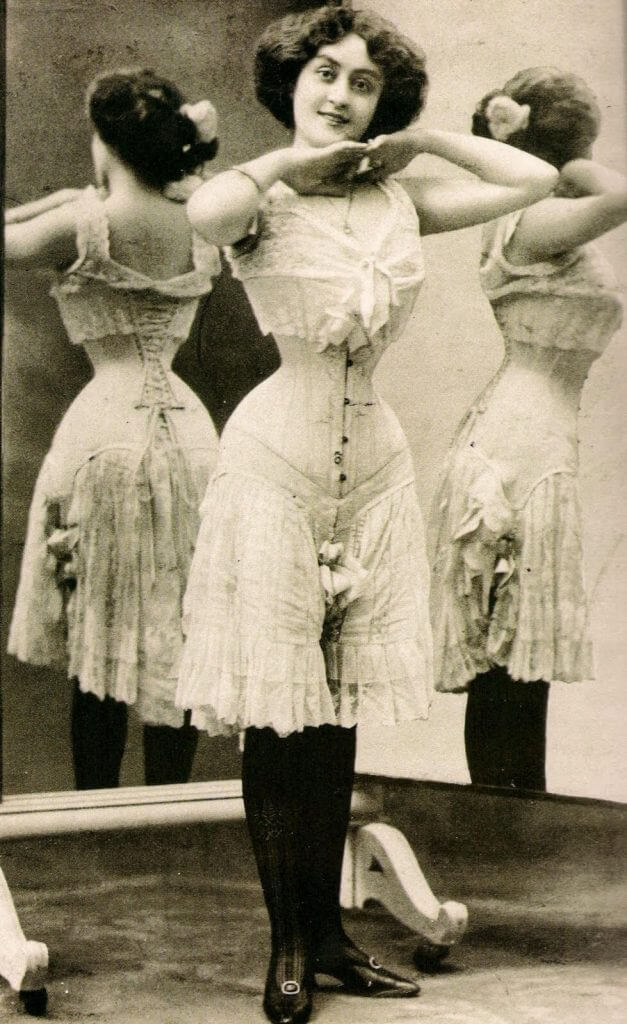Note to the reader: The following post describes in detail some of the dangerous activities women performed in the pursuit of beauty. Graphic detail will be used, so viewer discretion is advised.
Stiletto high heels. Corsets. Waxing, threading, plucking, epilating. Foot binding. Skin bleaching. Plastic surgery. Belladonna eye drops. Tanning beds. Dangerous diets and ‘supplements’.
The adage “beauty is pain” has always described our society, from the dawn of civilization to the modern day. Women (and on occasion, men), crippled and damaged their bodies in the vain pursuit of the “ideal form” and all that entailed. To me, the concept of “beauty is pain” is startling and mesmerizing, simultaneously fascinating and repulsive: the beauty fads of the begotten era seem so bizarre and obviously dangerous, yet the trends of today seem normal. If you had asked me a few years ago whether i shaped my eyebrows or shaved, whether I wore heels or painful clothing in pursuit of the aesthetic, I would have replied unthinkingly. Yes, of course I do. Who doesn’t?
Before I venture on into my thoughts about the relationship between beauty and suffering, I want to add a brief disclaimer. I do not aim to reject the beautification rituals we practice, nor do I want to promote a radical ideology against beauty standards in the modern era (at least, not in this post). I just want to explore why women and men have had to suffer in the name of beauty. Of course, to recount the history of beauty is to retell the history of human civilization; thus, I will be selecting a few of the most interesting trends and examining them, beginning my journey in 16th century China.

The practice of foot binding began in the tenth century in China during the reign of Emperor Li Yu. Legend says that court dancer named Yao Niang, who bound her feet into the shape of a new moon, entranced Emperor Li Yu by dancing on her toes inside a six-foot golden lotus adorned with ribbons and precious stones. Foot binding rose in popularity rose as women of the court attempted to emulate the dancer, and foot binding became a symbol of status and beauty.
The process of foot binding was quite gruesome, and began as early as age 4. The young girl’s foot would be washed and oiled to soften it, then her nails would be trimmed (or, in some cases, removed entirely). Then the toes would be bent under and back until the bones snapped, and the arch would be bent until the heel and the ball of the foot met. The foot would then be tightly and meticulously bound, encouraging the decay of flesh (for even smaller feet) as well as the painful reshaping of the foot.
Needless to say, this process was excruciatingly painful, and the girl’s foot bones would often break again and again until well after puberty. The best one could wish for would be a quick numbness and decay of the nerves in the foot (coincidentally, this is why foot binding often began in the winter- so that the girl’s feet would be as numb and unfeeling as possible). But this trend lasted long into the 19th and 20th centuries, despite multiple government crusades to eliminate the practice. Why? Small feet were venerated as a status symbol and a hallmark of beauty; attaining the perfect 4 inch ‘golden lotus’ foot greatly improved a young girl’s prospects for marriage and thus her and her family’s socioeconomic prosperity. Later, small feet symbolized the Chinese ethnic identity, as well as the principles of Confucianism women were instructed to devote themselves to.
Though perhaps the most gruesome and painful practice, foot binding is not the only example of drastic and dangerous extents women have gone to in the pursuit of beauty.

Dating back to the Minoan civilization of ancient Crete, the corset is perhaps one of the first things that come to mind when picturing an elegantly dressed lady of a bygone era. The history of this undergarment is long and convoluted, morphing from devices to support a woman’s bust to a contraption to ease back pain to an article of clothing designed to create a wasp-like waist line. Though they fell out of favor in the 1920s with the popularization of brasseries, corsets have reappeared in modern fashion, frequently dubbed as “waist trainers” promoting accelerated weight loss and overall fitness. But perhaps the most iconic image of a corset is pictured above- a young lady from the Victorian era, sporting a corset to create an exaggerated hour glass figure.
Though the corset may not appear as damaging as the practice of foot binding, tight lacing caused a myriad of ill effects on Victorian women (and children, who were also subjected to the whims of fashion). Restricted breathing could cause faintness and dizzy spells, ad in the most extreme cases, could shift the skeletal structure of the wearer. Cinched lungs may have aggravated cases of tuberculosis or pneumonia, and other internal organs were pinched and shifted in the pursuit of a more desirable silhouette.
My list may only contain two examples, but the truth of the saying “beauty is pain” extends well beyond foot binding and tight lacing. Women and men have suffered through the trials and tribulations fashion has lauded as admirable, putting their bodies (and sanity) at risk. Hopefully this post has inspired you to reexamine your daily routine, the paradigms of beauty you uphold. To conclude, I want to leave you with a question: what have you done to feel beautiful?

Leave a comment